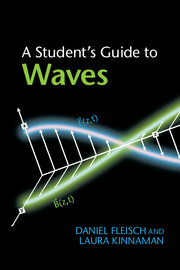6 - The quantum wave equation
Published online by Cambridge University Press: 05 April 2015
Summary
This is the third of three chapters that apply the concepts of Chapters 1, 2, and 3 to the three principal types of waves: mechanical, electromagnetic, and quantum. Although mechanical waves may be the most obvious in everyday life, and electromagnetic waves may be the most useful to our technological society, a case can be made that quantum waves are the most fundamental. As you'll see in this chapter, every bit of matter in the Universe behaves like a wave under certain circumstances, so it's hard to imagine anything more fundamental.
If you're thinking that life in the macroscopic world moves along just fine without considering quantum effects, you should realize that the laws of classical physics are approximations, and all the quantum weirdness described in this chapter blends smoothly with classical physics when they overlap. Much of that weirdness comes from the dual wave and particle nature of matter and energy, and one of the goals of this chapter is to help you understand what's actually doing all this waving.
This chapter begins with a comparison of the characteristics of waves and particles in Section 6.1, followed by a discussion of wave–particle duality in Section 6.2. You can read about the Schrödinger equation and probability wavefunctions in Sections 6.3 and 6.4, and quantum wave packets are discussed in Section 6.5.
Wave and particle characteristics
Before studying modern physics, most students think of particles and waves as belonging to fundamentally different categories of objects. That's understandable, because particles and waves have several very different characteristics, including the way in which they occupy space, the way they travel through openings, and the way they interact with other particles or waves. Here's a summary of some of the differentiating characteristics between particles and waves.
Occupying space. Particles exist in a well-defined amount of space; if you could pause time at some instant during a tennis match, all of the spectators would agree on the position of the ball at that instant.
- Type
- Chapter
- Information
- A Student's Guide to Waves , pp. 185 - 213Publisher: Cambridge University PressPrint publication year: 2015



